Integrating Google Analytics with your Shopify store can help you understand your traffic and improve your store's performance. Thankfully, adding Google Analytics is easy enough. Here is how to do it, step by step.
Let's dive in!
Before we dig in I want to show you something. I promise it's worth it...
Google Analytics is great, but also complex and a bit clunky. If you just want a straightforward dashboard with the insights you need, GA is not a great place to start. Additionally, Google doesn't care about privacy and GA requires an annoying cookie banner.
That's why I built Simple Analytics, a privacy-friendly and simple analytics tool - no personal data, no cookies, just the insights you need in a straightforward dashboard.
Here is how it looks vs GA. Feel free to check our live analytics to get an idea for your project. (It is free btw)
All right, enough about us. Now let's get into answering your question!

Integrating Google Analytics
Set up Google Analytics
- Log into your GA profile (or create one, if you haven't already)
- Create a GA property for your app.
- Inspect the property and note down your Measurement ID. You will need it later.
Navigate to Online Store Settings
In your Shopify admin, click on ‘Online Store’ and ’Preferences’.
Enter Your GA Measurement ID
Scroll down to the ‘Google Analytics’ section in the Preferences page. Here, you’ll see a field to enter your Google Analytics code. Paste your GA Measurement ID here.
Note: If you see a field labeled ‘Google Analytics account’, make sure you're using a GA4 property Measurement ID, not a UA (Universal Analytics) code.
Enable Enhanced Ecommerce (Optional)
Shopify supports GA's Enhanced Ecommerce features, which provide deeper insights into user behavior. To enable this:
- Check the box labeled ‘Use Enhanced Ecommerce’.
- Configure the Enhanced Ecommerce settings in your Google Analytics account.
Save Your Changes
After entering your Measurement ID and configuring settings as needed, save your changes.
Verify the Integration
To confirm that GA is tracking your site correctly, visit your Shopify store’s frontend and check the ‘Realtime’ section in your GA dashboard. You should see real-time data if the integration is successful.
(Optional) Create New Properties
To track multiple stores, create more GA properties and use the corresponding Measurement IDs. This prevents GA from conflating the data.
Final Thoughts
Adding Google Analytics to your store can give you great insights. However, ask yourself: is Google Analytics the right tool for you?
GA is an overpowered solution for straightforward analytics. If you're looking for a simple and intuitive dashboard with the insights you need, there are better alternatives. Yes, I’m talking about my own product (Simple Analytics), but there are others out there as well.
I hated using Google Analytics for my projects. It's clunky, there are hundreds of dashboards and it doesn't look appealing. Also Google doesn't care about privacy or ethics. That's why I decided to build my own and more intuitive web analytics tool.
If this resonates with you, feel free to give Simple Analytics a spin. You just need to add the script and off you go. This takes about one minute- and there is a free version as well!
Enjoy!
